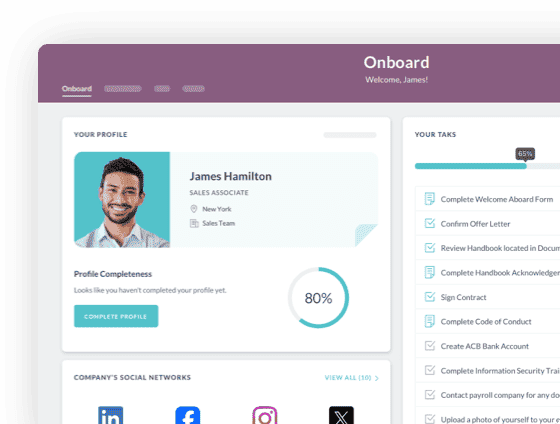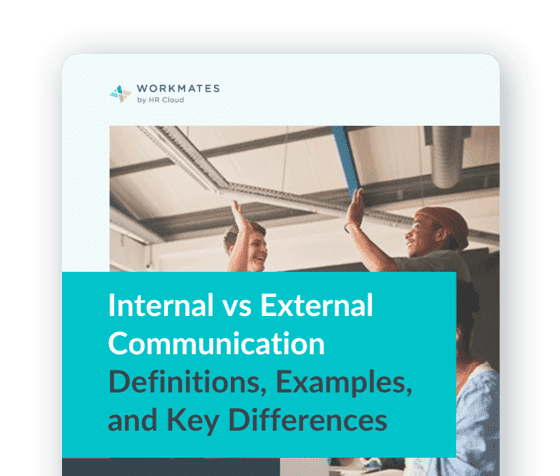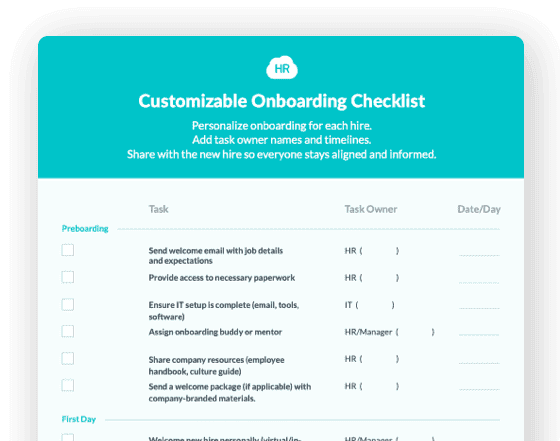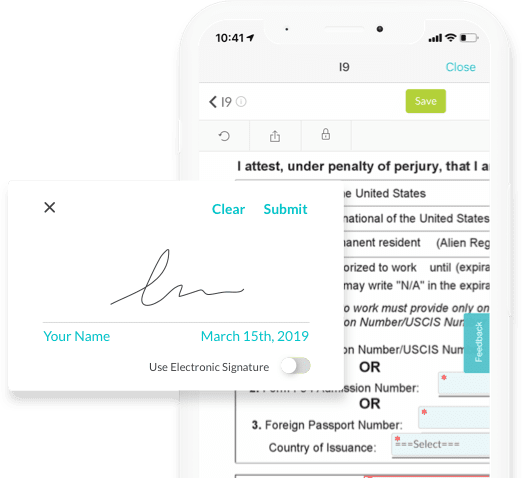

 Cut onboarding time
by 60%—here's the
Ultimate Checklist
that helped do it.
Cut onboarding time
by 60%—here's the
Ultimate Checklist
that helped do it.

How would you describe your company culture? Is it friendly, fun, or professional? If you want to attract top talent, you should consider implementing some new employee onboarding processes.
The importance of employee onboarding has never been greater. In today’s competitive job market, companies are looking for employees who are prepared to hit the ground running.
This means they need to invest time and energy into their new hires.
Employee onboarding is the process of welcoming new hires to your organization. It helps them get acclimated to the workplace and prepares them for success.
What Is An Employee Onboarding Process?
The main challenge for businesses is to find the right person for the job. This means that they need to hire someone who has the skills required to perform the job well. To do this, they must go through a rigorous hiring process.
They should interview candidates, test their knowledge, and evaluate their personality traits during this process. Once they have hired the best candidate, they must train them properly.
They also need to provide the new employee with all the necessary tools and resources they need to succeed. Finally, they must create a positive work environment where everyone feels comfortable and appreciated.
An employee onboarding process is a formalized way of introducing new hires to the company culture, policies, benefits, and expectations. Onboarding starts the moment the employee receives their offer letter. It also includes training new employees on how to use the systems in place at work, such as email marketing and CRM.
The function of employee onboarding processes is two-fold: To get new employees up to speed with the company's culture, policies, benefits, & expectations and to introduce them to the systems used by the business.
There are many reasons why you should have an employee onboarding process. Some include:
-
Help new hires understand the culture of the company
-
Ensure that new hires know about all the benefits offered by the company
-
Make sure new hires are aware of any special rules or regulations within the company
-
Provide training on using the systems in place at the company
-
Create a positive first impression
-
Give new hires a sense of belonging
-
Reduce turnover rates
-
Improve employee performance and productivity
Image source: Flair
The steps of an employee onboarding process are different depending on whether you're hiring full-time or part-time staff, in person or remote workers.
However, some common elements will be included in both cases. Here are the four main general components of an employee onboarding program:

Introducing Yourself
This step introduces the new hire to the team and company. It can take place over the phone, via video chat, or in person.
During this introduction, it's important to establish trust between the new hire and the rest of the team. You want to make sure that the new hire feels comfortable working with you.
Training
This step involves teaching new hires how to use the systems used by the company. For example, if you use Gmail, you'll need to teach new hires how to navigate the email system. If you use Salesforce, then you'll need help getting them familiar with the platform.
Getting to Know Each Other
This step involves having new hires meet each other face to face as well as everybody else in the office. This allows everyone involved to get to know one another better and build relationships.
‘Getting to know’ here can also refer to employees getting to know the company and its policies, procedures, systems, and software.
Establishing Expectations
Finally, this step establishes clear expectations for new hires. For example, you might tell new hires what kind of behavior is expected from them while at work. Or, you may explain what hours they should arrive and leave every day. These expectations are meant to ensure that everyone knows exactly what to expect when the start date for their job comes around.
Which Tools Will Help With Your Employee Onboarding Process?
When you think about your employee onboarding process, you probably think about all the things you do during the process. But, did you ever stop to consider which tools could actually help you?
In fact, here are five tools that can help you streamline the entire onboarding process:
1) Video Chat
Video chat has become increasingly popular among businesses because it's cost-effective and easy to set up. When you use video chat, you can connect with prospective hires anywhere in the world. You don't even need to be in the same building! All you need is a computer and internet connection.
2) Screencast Software
Screencasting software makes it possible for you to record yourself giving instructions and answering questions. Then, you can share those videos with anyone who needs to see them. This means that you no longer need to send out emails or post information online. Instead, you can simply create a screencast video and upload it to YouTube or to your knowledge base.
3) Applicant Tracking System (ATS)
An applicant tracking system helps companies manage the recruitment process. By using an ATS, you can easily track applicants' progress throughout the application process. You can also keep tabs on the status of applications so that you can quickly find qualified candidates.
4) Knowledge Base Software
Knowledge base software is great for onboarding as it is a localized space where you can store all the resources a new employee may need during the process. Think of it as a digital employee handbook. It can include organograms, video tutorials, PowerPoint templates, contacts, policies & procedures, learning material, and much more.
Having one storage place for all of this saves employees (new and old) valuable time as they do not need to scroll through and search multiple areas of your database.
5) Project Management Software
Having project management tools in place means that as your employees progress in their onboarding process, you can continue to assign them new tasks without even leaving your desk. You can also keep track of how far they are with every activity and make sure that they are progressing with ease.
6) Onboarding Software
Yes. You read that right. There is onboarding software available, such as HR Cloud (that’s us!), that helps you to automate all aspects of your employee onboarding process. Plus it takes everything and makes it digital meaning that you save valuable time when it comes to distributing, signing, and storing your employee contracts and knowledge base. Onboarding new employees has never been easier.
If you're looking for ways to improve your employee onboarding process and make it more efficient, then these tools can help.

They allow you to keep track of and communicate with potential employees wherever they happen to be and save time by eliminating the need to write emails or post information manually.
These tools also allow new hires to learn more about the company and the people who work there without actually being present in the same room. They also provide a means of communicating and collaborating with your current staff so that they can answer questions and give guidance.
It's important to note that not every company has the same needs when it comes to onboarding new hires. So, it's best to tailor your onboarding accordingly.
Why Would You Need A New Employee Onboarding Process?
When you hire an employee, you want them to succeed from day one. That means providing them with a smooth onboarding process, so they know what to expect when they start working for you.
Here are some reasons why you might need to build a new employee onboarding process:
1) Your existing onboarding process doesn't meet the needs of your new hires
Your existing onboarding process could be outdated, ineffective, or inefficient. If this is the case, then it's time to update it.
In order for your new hires to succeed, they need to understand how things work within your organization. It's essential that they get comfortable as soon as possible.
This means that you should provide them with everything they need to do their job effectively right away. For example, you should include training materials, manuals, and other resources to help them become productive as fast as possible.
2) The onboarding process takes too long
You've probably heard stories about how difficult it was for someone to join a company. But, did you know that it can take months before a person becomes fully integrated into the workplace?
That's because most organizations use a traditional onboarding instead of a virtual onboarding process. This involves sending out emails or posting information online.
If you're using this method, then the chances are good that your new hires won't be ready to perform their jobs until weeks later. The sooner you start setting expectations and goals, the better off you will be. The clearer your vision and mission are, the more likely you are to achieve your goals.
Remember: Hiring is an investment, not a cost. If you invest in your people, they will return the favor when they are ready.
3) Your onboarding process isn't engaging
Most companies use a traditional onboarding approach. This means that they send out emails or post information online. While this method does ensure that everyone receives all of the necessary information, it's not very engaging.
That's why you should consider building a new employee onboarding tool instead. These tools allow you to create a custom employee experience that's tailored specifically to your employees' needs.
The best way to keep your team motivated and united is to communicate clearly and frequently and to increase your employee engagement levels. Doing this will create an environment where people feel valued and appreciated. They will also feel like they have a voice within the organization.
4) There are too many people coming on board
It's common for companies to face a high volume of new hires. In fact, according to Glassdoor, there were over 9 million open positions in 2017 alone.
If you're struggling to manage the workload, then you'll want to make sure that your hiring process is efficient.
One way to do this is by creating a new employee onboarding program. With this type of system, you can streamline the entire process. If you're finding it hard to manage the number of new hires that come through your door, then you may need to revamp your onboarding process.
For instance, if you're hiring more than one hundred people per month, then you'll want a new onboarding process that allows you to scale easily.
5) You Have Switch To A Hybrid Workplace
Onboarding employees when they are right in front of you and under your beady eye is one thing. But, what about when they are thousands of miles away from you?
We suggest sending a welcome gift over so that you start off on the right foot!
You need a clearly defined remote and virtual onboarding process. You will most likely have to use a lot more employee monitoring software, meeting management software, and time tracking to ensure they are on task and completing all the onboarding tasks.

How To Build An Effective Employee Onboarding Process
To create an employee onboarding process, you must first understand why companies implement such processes. Then, you can decide which components of an employee onboarding plan work best for your business.
Image Source: MarketSplash
Here are some key factors to consider when building an effective employee onboarding process:
Create a clear onboarding plan
The first step in creating an effective employee onboarding process is to create a clear plan.
This should include your company’s goals, how long they expect employees to stay at your company, and any other information that may help them understand their role. You can use this information to determine whether or not you need to provide additional training, orientation, or mentorship.
Employees want to know where they stand and how they can get ahead.
Make sure that your onboarding process includes a clear path to success. This could mean providing access to resources, offering ongoing training, or allowing employees to ask questions about their roles.
Before starting the onboarding process, ensure that your employees have the necessary skills and knowledge to perform their jobs. You should also ensure that they have access to any training materials or resources that they need to succeed.
The first few days at a job are often the hardest. Be prepared to spend time explaining basic concepts like how to log into your computer system, how to navigate through your email, and how to work with other team members.
Make Sure Everyone Is On Board With Your Vision And Mission
Once everyone knows where the company is headed and understands their role in getting there, it’s time to make sure everyone is on board. In order to do this, you have to start by making sure your team members understand your vision and mission.
You may want to use some sort of visual representation to help them better grasp the big picture. Next, you should set clear expectations and goals for each person, including yourself.
Transparency
Another critical factor of an effective employee onboarding plan is transparency. Employees need to know where they stand within the company and what their responsibilities are. Transparency ensures that new hires understand the company culture and how things work around here.
The first step towards creating a culture of transparency is to have open communication between employees and management.
This can be done through regular meetings where both parties are able to discuss any issues that may arise openly. By having this type of dialogue, you will be able to identify problems before they become major issues.
Trust
This and transparency go hand in hand because there can be no trust without transparency and vice versa. New hires must trust the company and its leadership. Trust builds confidence in the new hire and helps them decide whether or not to stay on board.
It’s easy to get caught up in the excitement of hiring someone new and forget to tell them the truth.
Don’t lie to your new employee. Let them know right away if something isn’t going to work out. Let them go if you don’t think they are ready for the job. There is no point in wasting time and money training someone who won’t fit into your team.
Incentives
Don't forget to reward success!
Employee incentives play a significant role in helping new hires become productive team members. Incentives motivate new hires to do more than they were asked to do during the hiring process. For example, if a new hire completes a project early, then they could receive a bonus.
But with that being said, incentives don’t have to be monetary.
This incentive encourages the new hire to complete projects faster so that they can earn extra cash. It also shows that the company cares about its employees and wants them to succeed.
Training
New hires must be adequately trained so they can hit the ground running once they begin working.
Training provides new hires with the skills needed to perform their jobs effectively.

Once you’ve identified potential problems, you should provide training and education to your employees in an attempt to alleviate these stresses. This way, they will know how to handle these situations and prevent them from becoming more significant problems.
You should also make sure that your employees understand their roles and responsibilities. If they don’t, then they won’t be able to perform their jobs effectively.
Empowerment
An effective employee onboarding plan gives new hires the power to make decisions without being micromanaged. This empowers them to take ownership of their own success. It also allows them to learn quickly and grow as they gain experience.
By giving new hires the freedom to succeed, you help them build self-confidence and develop a sense of independence. This makes it easier to make each employee feel comfortable making mistakes, while still learning from them.
Follow-Ups & Feedback
Finally, you should provide regular feedback to ensure everyone is on track and moving forward together. Monitoring the progress of your new employees will allow you to stay on top of any potential problems and provide continuous support and training throughout their lifetime at the company.
But for feedback to be effective, it shouldn’t just go one way. You should ask your new employees to critically assess your onboarding process flow, Human Resource team, and hiring managers. This feedback is the main way in which you will know how effective your process is.
Employee onboarding is a continuous process.
In conclusion, an effective employee onboarding program helps you identify any potential issues before they become significant problems. Once you’re aware of these issues, you can address them immediately.
The sooner you act, the less damage you can cause to your business.
Onboarding is a long term investment. Onboarding starts from your employee’s first day and ends around 90 days after they have joined the company. Although, each employee is different from the next, so it is ideal if your onboarding process is slightly flexible so that you can adapt it on an individual basis.
#6 Saves Time for Employees
Workload and deadline stress increases with the daily commute, putting a damper on any workday. Aside from weekends, it is essential to relax, clear the mind, and reduce stress every day. And, working from home or co-working spaces saves you that time.
Everyone would like to spend some good time with their family in the few hours that go into traveling. This will help your employees stay sane and in a better mood that would reflect during working hours as well.
Author Bio: This article is written by our marketing team at HR Cloud. HR Cloud is dedicated to providing powerful solutions for your HR teams and creating an exceptional employee experience. Our aim is to help your company improve employee engagement, onboarding, and to save you valuable time!
Keep Reading
Top 10 Healthcare HR Challenges That Right HR Platform Can Solve
Healthcare HR teams in 2025 face mounting pressure. A 2025 NSI survey found average
I-9 Compliance in Healthcare: Simplify E-Verify and Stay Audit-Ready (Free Checklist Inside)
An audit notice lands on your desk and your stomach drops. Missing I-9s, late E-Verify
Perfect Onboarding App for Nurses: Get New Caregivers Shift-Ready Faster
A meta analysis at the beginning of 2025 found nurse turnover rate to be 15-18% globally.
Like What You Hear?
We'd love to chat with you more about how HR Cloud® can support your business's HR needs. Book Your Free Demo

Build a Culture of Recognition. Boost Engagement. Guaranteed.
Workmates empowers employees to stay informed, connected, and appreciated—whether they’re on the front line, in the office, or remote. Recognition drives 12x higher engagement.Trusted by industry leaders in every sector




Cut Onboarding Costs by 60%.
Take the confusion and follow-ups out of onboarding with automated workflows, digital forms, and structured portals—so new hires ramp faster 3X quicker.Trusted by industry leaders in every sector




-3.jpg)

